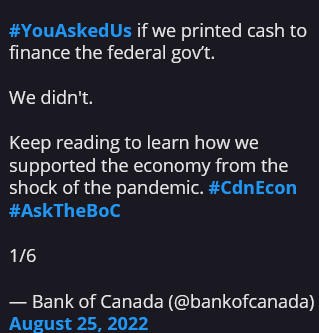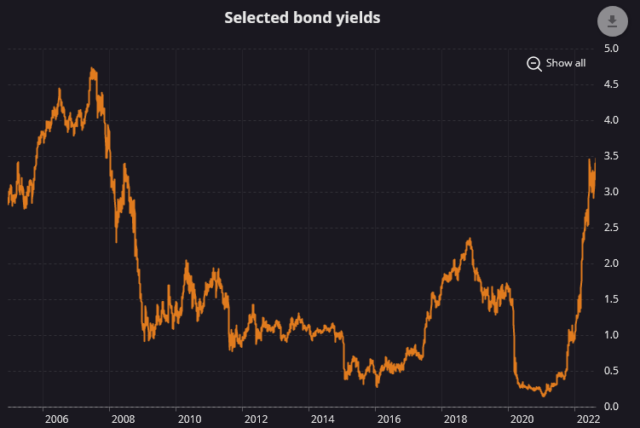It is ironic that one victim of higher interest rates is the Bank of Canada itself.
After engaging in a massive amount of quantitative easing, as of October 26, the Bank still has about $400 billion of government bonds on their books. They collect interest income from these bonds as payments are made (a journal entry from the Government of Canada to the Bank of Canada). You can view the holdings and come to a calculation of approximately $5.9 billion a year in interest income that the Bank will earn from their “investments”. The Bank stopped publishing exact details of their $11.8 billion provincial debt holdings in 2021, but if we just model it at 25bps higher than the federal government, we get another $200 million in interest income, for a total of $6.1 billion a year.
This modelling is not quite correct – the above calculations used strictly the coupon rate for the government debt securities, and not the more appropriate measure of using the market yield to maturity as the basis for the revenues earned for government debt. Using this metric, the calculation bears less revenues – the 2nd quarter report of the Bank of Canada indicated $1.163 billion in interest revenues, which equates to about $4.65 billion annually. The $6.1 billion estimate above is too generous.
Pay attention to a typical interest rate announcement. The first paragraph is the following:
The Bank of Canada today increased its target for the overnight rate to 3¾%, with the Bank Rate at 4% and the deposit rate at 3¾%. The Bank is also continuing its policy of quantitative tightening.
If you are a member bank and wanted to borrow money from the Bank of Canada for a day, you would pay the Bank Rate. Conversely, the Deposit Rate is the money the Bank of Canada gives you for parking your money in reserves.
However, in our world of quantitative easing, a significant portion of the government debt purchased by the Bank of Canada got converted into two primary liabilities – the Government of Canada account, and the reserves of member banks (“Members of Payments Canada”).
When QE was going on, these liabilities resulted in insignificant payments – the deposit rate was 0.25%. However, interest rate increases have significantly increased the deposit rate to the 3.75% we see today.
As of October 26, 2022, the Bank of Canada held $282 billion in reserves held by banks and the Government of Canada. With the deposit rate now at 3.75%, the Bank of Canada now has to pay off $10.6 billion and this only offset by roughly the $4.6 billion a year received from the Bank of Canada’s bond portfolio on an annualized basis (and subtracting amounts that get quantitative tightened over time). The Bank of Canada also has an operating budget (to pay for staff, office space, IT, etc.) which annualized, is around $720 million.
My quick paper napkin calculation suggests that at a 375bps rate, the Bank of Canada will be losing around $1.6 billion quarterly as long as they have the roughly $282 billion in deposits on their books (currently $96 billion held in the Government of Canada’s name, and $186 billion held in member bank reserves). If the Bank of Canada stops paying the Government of Canada, this number goes to about a $3 billion a year loss. This number gets reduced in 2023 if the Bank of Canada continues its QT program, but such stemming of losses would be potentially offset by further interest rate increases. The number only swings back to profit when the Bank has eliminated the reserves on its liability book, or if it chooses to decrease the deposit rate.
Section 27 of the Bank of Canada Act is the mechanism where the Bank will remit proceeds over a certain amount to the Government of Canada – essentially sending its profits to the government. The legislation does not work in the other direction – it is implied that the Bank of Canada will always be making money! Some minutiae of the Bank of Canada states the following:
At 31 December 1955, the statutory reserve had reached the maximum permitted under the Bank of Canada Act of five times the paid-up capital. Since then, all of the net revenue has been remitted to the Receiver General for Canada. Following an amendment to section 27.1 of the Bank of Canada Act, the special reserve was created in 2007 to offset potential unrealized valuation losses due to changes in the fair value of the Bank’s investment portfolio. An initial amount of $100 million was established at that time, and the reserve is subject to a ceiling of $400 million. Effective 1 January 2010, based on an agreement with the Minister of Finance, the Bank will deduct from its remittances an amount equal to unrealized losses on available-for-sale assets. Prior to 25 March 2020, this category includes Other deposits.
The government has generously allowed the Bank of Canada to deduct its losses from the 2008-2009 economic crisis, which was not really needed because the Bank did not engage in wholesale QE during that era (less than $40 billion of reverse repurchases, which is a drop in the bucket compared to the numbers we see today – and they were settled in 2010).
However, this time is different, and the Bank of Canada will be facing significant losses as long as interest rates continue to remain at elevated levels. Their Q3 report will show a loss, and their Q4 report will show a big loss. It will blow through the $400 million reserve in short order.
I can imagine the upcoming hilarity that is going to occur on November 3, when the government announces the fiscal update which will likely include more “anti-inflationary (deficit) spending”. Part of this hilarity involves the government having to draft legislation to permit the Bank of Canada to incur losses and beg for money to keep operating. Just imagine the political backlash when Canadians learn that the Bank of Canada will be one more fiscal lead anchor that the public has to subsidize and also the sight of Tiff Macklem going to Finance and begging for money from the government to maintain the payroll.

